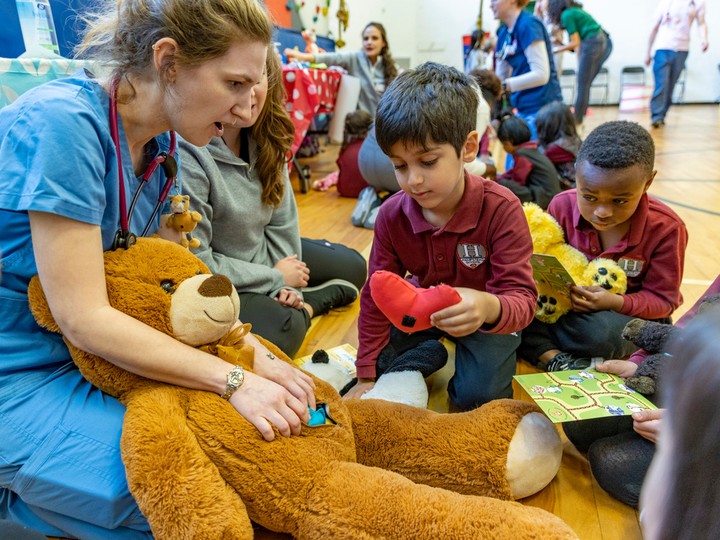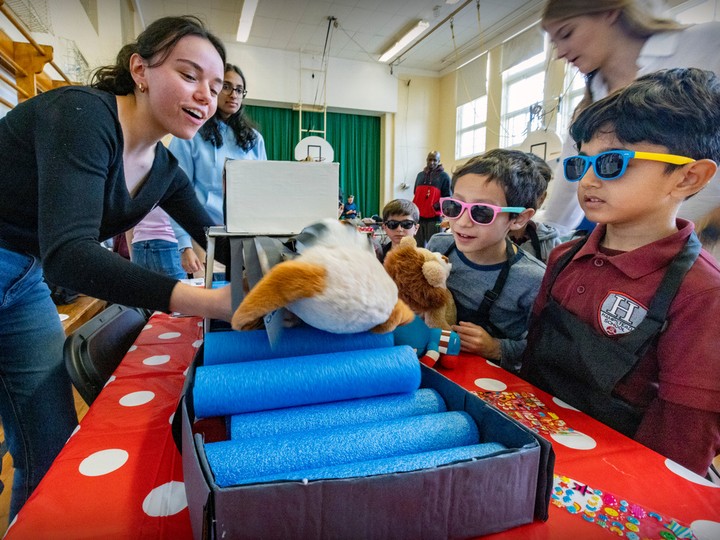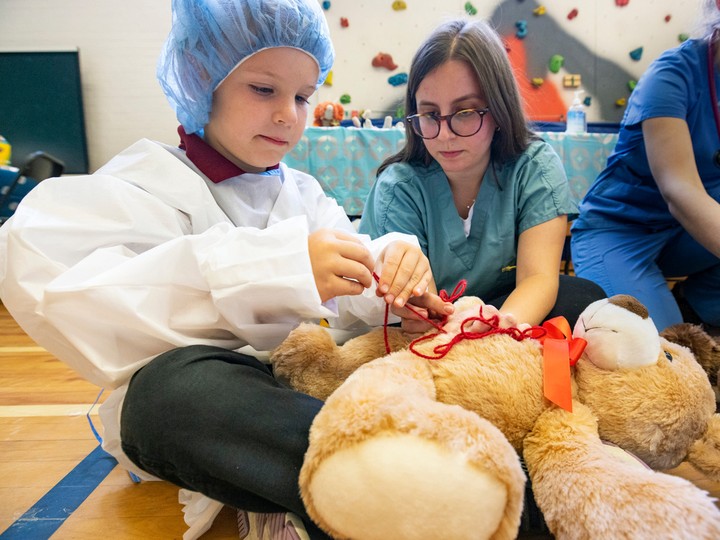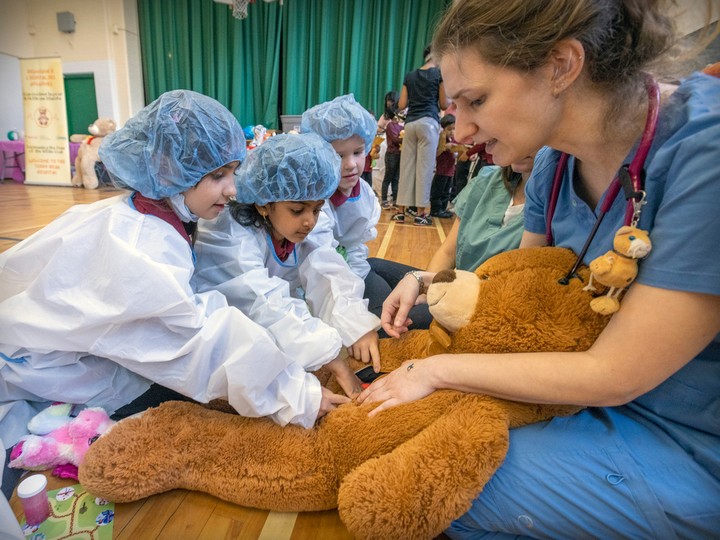at this mcgill teddy bear hospital, children are the doctors
the program helps demystify medical procedures and alleviates anxiety. as they go through the stations, "the kids come up with ideas on how not to be scared.”
we apologize, but this video has failed to load.
try refreshing your browser, or
tap here to see other videos from our team.
tap here to see other videos from our team.
the children were the doctors and their teddy bears the patients as the gymnasium at hampstead elementary school was transformed for the day into a teddy bear hospital.
pre-k through grade 2 students at the english montreal school board school spent part of last friday moving with their teddy bears through several stations, including a physical exam station, medical imaging and surgery.
“the kids get to be doctors of their own teddy bears,” explained alejandra martinez, a fourth-year medical student in mcgill university’s faculty of medicine and health sciences and co-founder and co-president, with classmate bertrand leduc, of the mcgill teddy bear hospital project. martinez, 25, hopes to become a pediatrician.
the idea behind the project is to make encounters with doctors and hospitals less frightening for children. the first teddy bear hospital was established by the german medical student association in 2000. today these “hospitals,” an initiative of the international federation of medical students’ associations, are in place at mcgill and other quebec universities, elsewhere in canada and in europe.
at mcgill, students in health-science disciplines including nursing, nutrition, physiotherapy and occupational therapy are involved in the project along with the medical students.
2
advertisement
the experience is designed to be fun for the children: each receives a map of the various stations and, after going through each station, a sticker. “they love it,” martinez said. “they are so proud of their map and want to have all the stickers.”
mcgill held its first teddy bear hospital event in june at st-gabriel school in pointe-st-charles; the second was in july at a montreal north day camp run by the fourchettes de l’espoir organization. the children asked eagerly for a repeat visit, she said.
educating children ahead of interactions with the medical community is an effective way to alleviate fear — and it is known that children who are less frightened experience less anxiety and less pain, she said.
“the little ones are so curious and open to the world,” said dr. mylène dandavino, an associate professor of pediatrics at mcgill who practises hospital-based pediatrics at the montreal children’s hospital; she is the students’ supervisor on the project.
“it is really nice to have an intervention that shows them they have nothing to fear.”

grade one student mahdiyar taghvaee takes a heart from a stuffed bear held by mcgill fourth-year medical student edith corriveau-parenteau at the surgical station during the teddy bear hospital event at hampstead elementary school.
john mahoney
/
montreal gazette
in examining their teddy bear, doing everything from checking the blood pressure and temperature to other vital signs and listening to the heartbeat, weighing him — or her — and examining the ears, the children are helping the bear go through all that a healthy child does in a check-up, martinez said.
3
advertisement
at the medical imaging station, where a teddy bear might have a broken arm and has to go through an pretend x-ray machine, “the kids come up with ideas on how not to be scared,” she said.
the occupational therapy station might feature a wheelchair or a cane and “the main message of the station is that just because they move differently doesn’t mean you can’t be friends.”

grade 1 students schlok sharma, right, and sebastian rodriguez chaparro wear dark glasses to watch as first year mcgill medical student jenna gregory runs their stuffed animals through a pretend x-ray machine.
john mahoney
/
montreal gazette
at the pharmacy stations, bottles are identified by hearts, stars and circles and children must choose different ingredients to mix teddy’s “medicine.” the message of the station, martinez said, is not to take medicine that isn’t yours.
the surgery station features a giant teddy bear whose internal organs become visible when a zipper down the front of the bear is unzipped: the heart, lungs, stomach and intestines are fashioned of fabric and stuffed. the children search the organs looking for the “sad worm,” which stands in for the appendix: the bear has belly pain, martinez explained, because he has appendicitis.
the children also don caps and gloves and, using yarn, learn to suture the teddy bear by tying knots. “it’s a fun game,” she said.
for the medical students to plan and design the stations required a great deal of thought, time and effort, dandavino said, and provided an important learning experience.
4
advertisement
they worked hard to develop the concepts for the teddy bear hospital, prepare the scenarios and scripts, get approval and collect sponsorships and medical supplies including caps and surgical gloves for the children, she said.
“they are energetic and motivated — and committed to really making a difference,” dandavino said.

second-year mcgill medical student lauren perlman helps grade 1 student petro kolodiichuk suture, or stitch up, a teddy bear with yarn following “surgery” at the teddy bear hospital.
john mahoney
/
montreal gazette
the students are considering developing a research project around the school-based vaccination program, she said, and this would provide another opportunity to work with the children.
many of the medical students hope to practise pediatrics, she said, so it’s important to learn to hold the attention of children and communicate well with them. and as they learn, they’re also learning to be teachers. and as dandavino observed, the word doctor is derived from the latin verb docere: it means to teach.
sign up for our awesome parenting newsletter at montrealgazette.com/newsletters.

grade one students, from left, raya jalalian, koshika vivek and petro kolodiichuk take organs from a stuffed bear held by mcgill fourth-year medical student edith corriveau-parenteau while performing “surgery” at a teddy bear hospital at hampstead elementary school.
john mahoney
/
montreal gazette
 3 minute read
3 minute read

